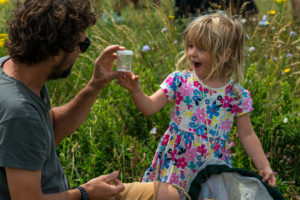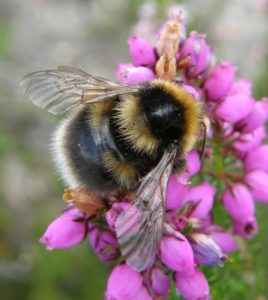Outcome 3: Habitats and Species
A thriving and connected network of habitats and increased population and distribution of priority species now exist in the National Park.
- WHY IS IT IMPORTANT?
The National Park has a high proportion of sites designated for their wildlife value, including nationally and internationally important sites and over 800 locally designated wildlife sites.
Habitats include chalk grassland, lowland heathland, ancient woodland, farmland, rivers and other wetland habitats, coastal and adjacent marine habitats. There are also two neighbouring Marine Conservation Zones.
But these ecosystems have, as elsewhere, suffered significant damage over the last 150 years through loss of habitats, their fragmentation and degradation.
Factors such as climate change, new diseases and invasive species are adding to
this pressure. In order to create more resilience, urgent action is being taken to ensure that habitats are better managed, bigger and more joined up.This is essential because species will need to be able to move through the landscape if they are to adapt to change, this means looking well beyond nature reserves and working across the wider farmed countryside.
For this outcome our priorities for the next five years are:
- 3.1 JOIN UP HABITATS
To create, restore and improve areas of priority habitat to be more, bigger, better, and joined up at a landscape scale.
The National Park has a rich mosaic of habitats including species-rich chalk grassland, crystal clear chalk streams, precious acid heathland and ancient deciduous woodland.
However, many are fragmented and some species populations have become isolated. Through concerted actions by landowners we will continue the approach set out by Prof Sir John Lawton in Making Space for Nature − joining up important areas of habitat, making key sites larger and improving their management condition.
This Nature Recovery Network needs to extend well beyond the National Park boundary and connect with our neighbouring AONBs.
The Authority will support this vital work by pulling together information from the habitat capability mapping tool, biodiversity opportunity areas and ecosystem service mapping.
Land managers will work together with conservation organisations to target the best locations to develop connectivity, enlarge existing habitats and improve their quality.
Example: Changing Chalk
 Changing Chalk is a distinctive peri-urban project led by the National Trust with many other partners. It focuses on the chalk grassland landscape of the eastern Downs and the communities of the coastal urban fringe of Brighton and
Changing Chalk is a distinctive peri-urban project led by the National Trust with many other partners. It focuses on the chalk grassland landscape of the eastern Downs and the communities of the coastal urban fringe of Brighton and
Hove, Eastbourne and Newhaven.This densely populated coastal area is immediately next to the fragile chalk
grassland, which is facing rapid decline with only 4% of original habitat remaining.The area has some of the most economically deprived wards in the UK with high levels of unemployment and reports of young people feeling disconnected and isolated.
Through 24 different streams of activity, this new and ambitious project will bring together people and nature to tackle the threats to our chalk grassland and to grasp the opportunities that the area offers.
The vision is to reverse the decline in chalk grassland and establish a long-term collaborative management plan which is sustainable because of the benefits it will provide for people.
- 3.2 MANAGE PRIORITY AND INVASIVE SPECIES
To increase the genetic diversity and resilience of target species and implement a landscape scale strategy for tackling invasive species, pests and diseases.
The National Park supports many iconic species such as burnt orchids, sand lizards, barbastelle bats and brown trout. Many are rare and localised but the populations of some − such as the otter and Duke of Burgundy butterfly – are
recovering through sensitive management and improving habitat connectivity.Other species, such as the wart biter cricket and the water vole, have had a helping hand with the introduction of new populations. The actions in 3.1, will increase
the populations of key species by creating corridors for species movement, and improving genetic diversity by enabling populations to exist across a wider geographical range.These will be supplemented where necessary with introductions of wildlife lost to the area – recent examples include plans to bring back the beaver and the pine marten.
Invasive non-native species, pests and diseases are a major issue on a global scale − both in terms of damage to native ecosystems but also health and economic impacts.
In the UK the economic impact of control and containment is estimated at £2 billion per annum. Locally, in the South Downs, both invasive non-native species
and pests and diseases are a growing problem.We will continue to focus on the prevention, control and eradication of those that are most harmful to our native biodiversity.
Example: Bee-Lines

Species-rich Downland is the iconic habitat of the chalk landscape and is traditionally managed through grazing, particularly by specialist sheep breeds such as the Southdown and Hampshire Down.
During World War II many of the chalk grassland sites in the South Downs were
ploughed and have remained under cultivation.More recently, intensification of farming methods has contributed to
the loss and decline of this important habitat.This new project aims to improve management and increase connectivity
between fragmented chalk grassland sites by working with farmers, schools
and other organisations within the Arun and Adur river areas.It will identify the current areas strong in wildlife and the which have the potential to connect them.
The project will also seek to source a selection of native and locally sourced flowering plant seeds, which are not currently commercially available.
